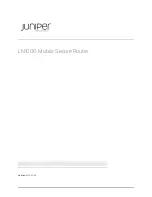
VIP-FE-TX/4E Installation and Configuration 33
VIP Port Adapter Functions
The bank of three status LEDs indicates the following:
•
MII—On when the MII port is selected as the active port by the controller.
•
Link—When the RJ-45 port is active, this LED is on when the FE-TX port adapter is receiving
a carrier signal from the network. When the MII port is active, this LED is an indication of
network activity, and it flickers on and off proportionally to this activity.
•
RJ-45—On when the RJ-45 port is selected as the active port by the controller.
Either the MII LED or the RJ-45 LED should be on at any one time; never both.
Figure 15
LEDs on the FE-TX Port Adapter (Horizontal Orientation Shown)
Note
The VIP is oriented horizontally in the Cisco 7010 and Cisco 7505, and vertically in the Cisco
7000, the Cisco 7507, and the Cisco 7513.
FE-TX Port Adapter Receptacles, Cables, and Pinouts
The two interface receptacles on the FE-TX port adapter are a single MII, 40-pin, D-shell type, and
a single RJ-45. You can use either one or the other. Only one receptacle can be used at one time. Each
connection supports IEEE 802.3u interfaces compliant with the 100BASE-X and 100BASE-T
standards. The RJ-45 connection does not require an external transceiver. The MII connection
requires an external physical sublayer (PHY) and an external transceiver.
Figure 16 shows the RJ-45 connectors. Table 3 lists the pinouts and signals for the FE-TX RJ-45
connectors.
Figure 16
FE-TX RJ-45 Connections, Plug and Receptacle
Warning
The ports labeled “Ethernet,” “10BaseT,” “Token Ring,” “Console,” and “AUX” are
safety extra-low voltage (SELV) circuits. SELV circuits should only be connected to other SELV
circuits. Because the BRI circuits are treated like telephone-network voltage, avoid connecting the
SELV circuit to the telephone network voltage (TNV) circuits. (For translated versions of this
warning, refer to the section “SELV Circuit Warning Translations” on page 57.)
H4710
H2936
8 7 6 5 4 3 2 1
J-45 connector
















































